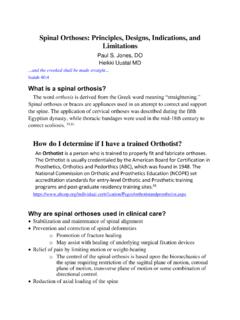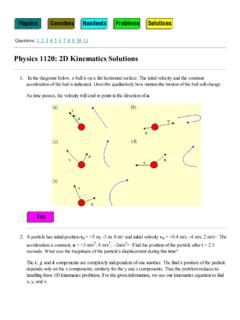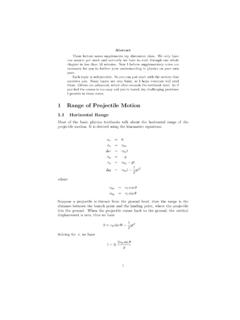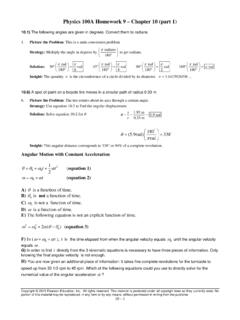Transcription of Normal Gait - MU School of Medicine
1 Normal gait Heikki Uustal, MD. Medical Director, Prosthetic/Orthotic Team JFK-Johnson Rehab Institute Edison, NJ. 1. Critical gait Parameters n Average walking speed = 2-3 mph (60- 80m/min). n Average cadence = 80-110 steps/min n Average step length = 60 cm n Stance/swing = 60/40. n Single/double limb support = 80/20. n Running has no double limb support 2. Step or Stride? 3. Phases of the gait Cycle Stance Phase 60%. Swing Phase 40%. 4. Comparison of Right Leg to Left Leg Phases 5. Three Important gait Factors n Forward Progression n Stance Stability n Conservation of Energy 6. Methods of Analyzing gait n kinematics is the method of observing or measuring the position of joints and segments through each phase of gait (visual gait analysis). n Kinetics is the method of measuring the Ground Reaction Force at each joint and then calculating the muscle activity or soft tissue resistance present to stabilize the joint 7. gait Analysis Basic Training n Assess only one joint at a time n Look at early stance, late stance, then swing n Separate kinetics from kinematics n KEEP IT SIMPLE!
2 8. Normal Human Locomotion: Sagittal Plane gait kinematics 9. 10. 11. Rockers or Pivot Points in Stance 12. Initial Contact: Double Support Hip = Flexed 30*. Knee = Extended Ankle = Neutral Goal = Begin Stance 13. Loading Response: Double Support Hip = Flexed Knee = Flexing 5-10*. Ankle = Plantarflexing to 20*. Goals = Weight Acceptance, Shock Absorption, Advance body over Heel Rocker 14. Mid Stance: Single Support Hip = Extending Knee = Extending but not to 0*. Ankle = Dorsiflexing Goal = Advance body over stationary foot, ankle rocker 15. Terminal Stance: Single Support Hip = Extending 15-30*. Knee = Extend, then Flex Ankle =15* DF to Neutral Goal = Advance body over forefoot rocker 16. Pre Swing: Double Support Hip = Flexing Knee = Flexing 30-40*. Ankle = Plantarflexing 20-30*. Goal = Prepare for Swing, transfer load to other limb 17. Initial Swing: Single Support Hip = Flexing Knee = Flexing up to 65*. Ankle =Dorsiflexing to 0*. Goal = Clear foot and advance limb 18.
3 Mid Swing: Single Support Hip = Flexing to 30*. Knee = Extending Ankle =Dorsiflexing to 0*. Goal = Advance limb and clear foot 19. Terminal Swing: Single Support Hip = Flexed 30*. Knee = Extending Ankle = Neutral Goal = Advance limb 20. Initial Contact: Double Support Hip = Flexed 30*. Knee = Extended Ankle = Neutral Goal = Begin Stance 21. Kinetics of Stance Phase 22. Activity of All Major Muscles 23. Activity of All Major Muscles 24. Hip Abductor Activity 25. Determinants of gait Stick Figure Model 26. Rotation Lengthens Limb at IC and PS. 27. Tilt Shortens Limb at MS. 28. Flexion in Stance Shortens Limb at MS. 29. 4& and Ankle motion Lengthens and Shortens Limb 30. Sinusoidal motion of the COG. 31. Base of Support to Minimize Horizontal motion 32. Effect of Incline on Energy 33. Effect of Ankle Immobilization on gait 34. Effect of Knee Immobilization 35. Up and Down Stairs 36. Center of Gravity Line 37. Base of Support 38. Base of Support 39. Thank You 40.





